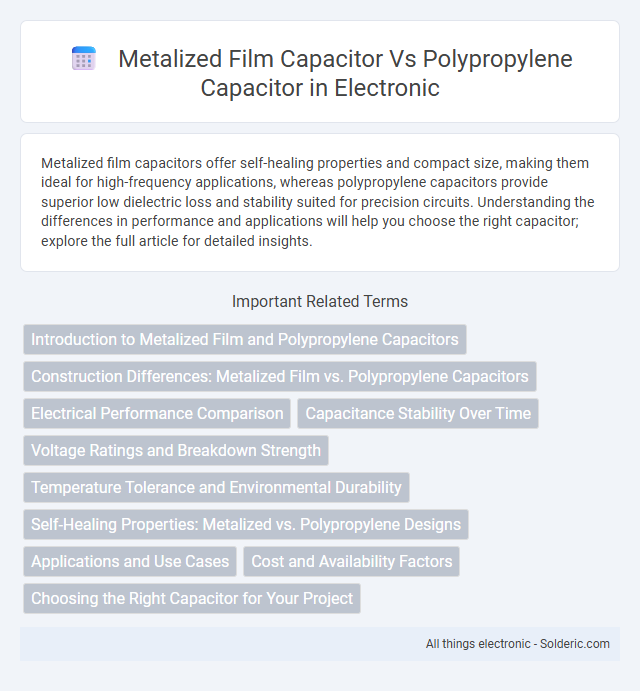Metalized film capacitors offer self-healing properties and compact size, making them ideal for high-frequency applications, whereas polypropylene capacitors provide superior low dielectric loss and stability suited for precision circuits. Understanding the differences in performance and applications will help you choose the right capacitor; explore the full article for detailed insights.
Comparison Table
| Feature | Metalized Film Capacitor | Polypropylene Capacitor |
|---|---|---|
| Dielectric Material | Metalized Film (various polymers) | Polypropylene Film |
| Capacitance Range | 1 pF to several uF | 100 pF to several uF |
| Voltage Rating | Up to 3 kV typical | Up to 1.5 kV typical |
| Tolerance | +-5% to +-10% | +-1% to +-5% |
| Temperature Stability | Good | Excellent |
| Dielectric Loss (tan d) | Higher than polypropylene | Very Low (0.0002 at 1 kHz) |
| Self-Healing Property | Yes, due to metalized layer | No |
| Application | General-purpose, filtering, coupling | Precision circuits, audio, RF, timing |
| Cost | Lower | Higher |
| Size | Smaller for same capacitance | Larger for same capacitance |
Introduction to Metalized Film and Polypropylene Capacitors
Metalized film capacitors feature a thin metal layer deposited on a plastic film, offering self-healing properties and compact size, while polypropylene capacitors use polypropylene film as their dielectric, known for low dielectric loss and high insulation resistance. Metalized film capacitors excel in applications requiring high capacitance and reliability, whereas polypropylene capacitors provide superior performance in precision and high-frequency circuits. Your choice between these capacitors depends on the specific electrical characteristics and operational environment required for your application.
Construction Differences: Metalized Film vs. Polypropylene Capacitors
Metalized film capacitors use a thin metal layer vapor-deposited onto a plastic film as electrodes, enabling self-healing properties that enhance reliability and longevity. Polypropylene capacitors employ stacked polypropylene film layers with foil electrodes, offering superior dielectric strength and low dissipation factor ideal for high-frequency applications. The construction differences impact performance, with metalized film capacitors being more compact and cost-effective, whereas polypropylene capacitors excel in stability and low-loss characteristics.
Electrical Performance Comparison
Metalized film capacitors exhibit self-healing properties, allowing them to recover from dielectric breakdowns and maintain long-term reliability, whereas polypropylene capacitors offer superior dielectric strength and lower dissipation factor, resulting in minimal energy loss. Polypropylene capacitors demonstrate excellent frequency stability and low dielectric absorption, making them ideal for high-frequency and precision filtering applications. Metalized film capacitors generally provide higher capacitance per volume, but polypropylene capacitors deliver better electrical performance in terms of insulation resistance and temperature stability.
Capacitance Stability Over Time
Metalized film capacitors exhibit superior capacitance stability over time due to their self-healing properties that prevent degradation from dielectric breakdowns. Polypropylene capacitors also maintain stable capacitance but can suffer from increased losses and slight capacitance drift under high temperature or prolonged operation. Performance data indicates metalized film capacitors typically retain over 90% capacitance after 1,000 hours at elevated temperatures, whereas polypropylene capacitors may decline to around 85-90%.
Voltage Ratings and Breakdown Strength
Metalized film capacitors typically offer voltage ratings ranging from 100V to 1000V, with a moderate breakdown strength due to their thin dielectric layers, which enhances self-healing capabilities. Polypropylene capacitors exhibit higher breakdown strength and can handle voltage ratings up to 2500V or more, making them suitable for high-voltage and high-reliability applications. The superior dielectric properties of polypropylene film result in lower dielectric losses and improved voltage endurance compared to metalized film capacitors.
Temperature Tolerance and Environmental Durability
Metalized film capacitors typically offer excellent temperature tolerance, functioning reliably in ranges from -55degC up to 125degC, which suits demanding electronic applications. Polypropylene capacitors excel in environmental durability, displaying high resistance to moisture, chemicals, and thermal aging, ensuring long-term stability even under harsh conditions. Their dielectric properties contribute to low loss and high insulation resistance, making polypropylene capacitors preferred in precision and high-frequency circuits.
Self-Healing Properties: Metalized vs. Polypropylene Designs
Metalized film capacitors feature a thin metal layer that enables self-healing by vaporizing small fault areas, maintaining capacitor performance and extending lifespan. Polypropylene capacitors, while offering excellent electrical characteristics and low dielectric loss, typically lack inherent self-healing capabilities found in metalized designs. When selecting a capacitor for your application, understanding the self-healing difference helps optimize reliability and durability.
Applications and Use Cases
Metalized film capacitors are widely used in power supply filtering, pulse discharge, and self-healing applications due to their compact size and ability to handle high voltage surges. Polypropylene capacitors excel in audio equipment, precision measurement instruments, and DC-link circuits for inverters because of their low dielectric loss, high insulation resistance, and superior voltage stability. Both types are preferred in industrial electronics, with metalized film capacitors favored for space-saving designs and polypropylene capacitors chosen for high-frequency, high-precision environments.
Cost and Availability Factors
Metalized film capacitors generally have a lower cost due to simpler manufacturing processes and widespread availability in various capacitance values and voltage ratings. Polypropylene capacitors tend to be more expensive because of higher raw material costs and specialized production techniques, leading to limited availability in certain specifications. Your choice may depend on budget constraints and the specific performance requirements of your application.
Choosing the Right Capacitor for Your Project
Metalized film capacitors offer self-healing properties and compact size, ideal for circuits needing durability and space efficiency, whereas polypropylene capacitors provide superior insulation resistance and low dielectric loss, making them suitable for high-frequency and precision applications. Your choice depends on prioritizing performance factors such as voltage stability, frequency tolerance, and capacitance range. Evaluating environmental conditions and budget constraints ensures selecting the optimal capacitor type for reliable and efficient project outcomes.
metalized film capacitor vs polypropylene capacitor Infographic

 solderic.com
solderic.com